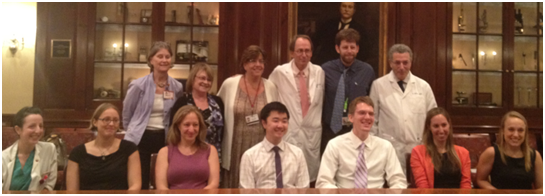As the Grants Manager at the Foundation, my access to grantees is mostly limited to the reports they periodically send to us and the occasional evaluation site visit I attend. So, my focus is usally on the numbers: how grantees spend the money we awarded them and whether they are up to date on their requirements. But these numbers give only half the story of what we, as a Foundation, fund and how those funds contribute to improving the health of older adults.
Last week, along with many of my Foundation colleagues, I attended an event at the Weill Cornell Medical College featuring the exciting “end products” of one of our projects, the Medical Student Training in Aging Research Program (or MSTAR). The program enables medical students from across the country to learn about geriatric medicine and conduct research projects that aim to improve the care of older adults.
 Shown in the picture are seven of the students and their mentors who participated in the program at the Cornell Division of Geriatric Medicine in New York (also a Hartford Center of Excellence in Geriatric Medicine). Their work showed me the wide range of problems that can befall an elderly patient and the solutions that can improve their care and produce better health outcomes.
Shown in the picture are seven of the students and their mentors who participated in the program at the Cornell Division of Geriatric Medicine in New York (also a Hartford Center of Excellence in Geriatric Medicine). Their work showed me the wide range of problems that can befall an elderly patient and the solutions that can improve their care and produce better health outcomes.
The students’ research dealt with eye care, substance abuse, delirium, dementia, and palliative care. The enthusiasm of each of the students was infectious, and each of us staff who attended came back feeling satisfied with the work that the Foundation does. We are particularly proud of the soon-to-be-doctor Scott Connors, who was supported in his summer experience by a special contribution from Foundation Trustee Mrs. Kathy Wriston.
The project is masterfully managed by the American Federation for Aging Research (AFAR). It began in 1993 as the Medical Student Geriatric Scholars Program and has had five subsequent Hartford renewals (with another one on the way in September). It is co-funded by the National Institute on Aging and the MetLife Foundation. Students pair with at least one physician mentor who specializes in geriatric medicine. At the end of the eight-to-twelve week summer program, these students present their research findings.
It is at meetings like these that I can get the full picture and appreciate our grantees and the work that they do to help further the Foundation’s mission of improved health care for older adults.
What makes this program unique is that the Foundation, and by extension AFAR, is trying to attract medical students into geriatric care and/or gerontology careers from the get-go, instead of attempting the usual (and more difficult) task of catching professionals in mid-career and steering them toward this field.
Targeting this younger cohort offers some real advantages: (1) should they decide to stay in the field, they will likely be in it for the long haul; and (2) they will provide long-term replacement for those already in the field who are set to retire in the coming years.
What I also learned in this meeting was that many of these students are going to graduate from medical school with enormous amounts of debt, and if not given the right incentives, they will go elsewhere for more lucrative opportunities in health care. Geriatrics, as I have learned--much to my shock and dismay--throughout my years here is one of the lowest paying specialties in medicine. This must change, and it can only do so with funders like Hartford and organizations like AFAR, two organizations dedicated to growth in this field.
The numbers are important, and they do tell a story in their own right, but they don’t give the big picture view of a grant’s successes or failures. Attending this event and meeting some of the players involved gave me that added perspective that I needed to see how well all of the moving parts of this project work together at making this grant, in my view, a success. We may not be able to keep everyone who comes through this program in geriatric medicine because of the reasons stated above, but we can at least plant the seed and make them aware of the needs of the elder population in the U.S. and inform their practice after graduation. I love numbers, but nothing beats a good dose of reality to pull everything together and make things come alive.
